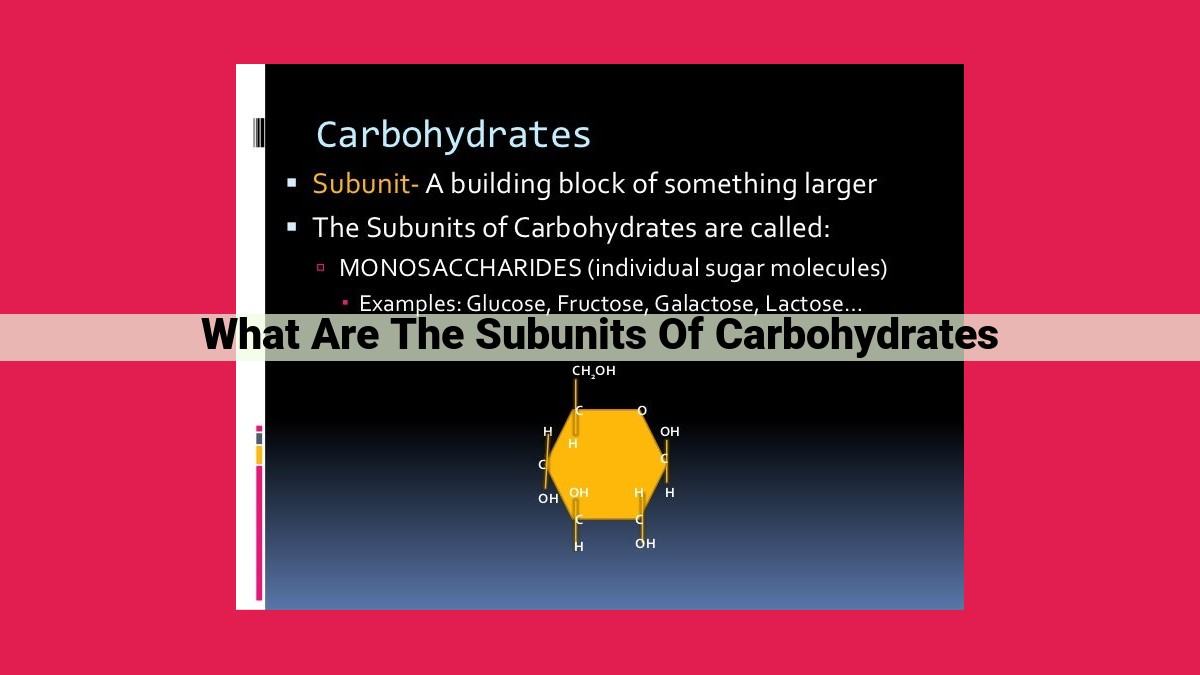Carbohydrates: The Essential Macronutrients For Energy And Cell Function

Carbohydrates are macronutrients that provide energy and contribute to cell function. Their subunits are:
– Monosaccharides: single units of sugar (e.g., glucose)
– Disaccharides: pairs of monosaccharides linked together (e.g., sucrose)
– Oligosaccharides: short chains of monosaccharides
– Polysaccharides: complex chains of monosaccharides (e.g., starch)
Carbohydrates: The Body’s Essential Energy Source
Carbohydrates, one of the three macronutrients, play a crucial role in nourishing our bodies and fueling our cells. They are the body’s primary source of energy and provide the building blocks for a multitude of essential cellular processes.
Carbohydrates, composed of carbon, hydrogen, and oxygen, exist in various forms, classified based on their molecular structure and complexity. Understanding the different types of carbohydrates is key to appreciating their diverse functions in the body.
Types of Carbohydrates: Monosaccharides
- Definition of monosaccharides as the simplest carbohydrates.
- Examples of common monosaccharides (glucose, fructose, galactose) and their sources.
Monosaccharides: The Simplest Carbs
Monosaccharides are the most basic type of carbohydrates, serving as the building blocks for larger, more complex ones. They’re like single Lego bricks that can connect to form intricate structures.
Glucose is the main monosaccharide and a primary fuel for our bodies. It’s found in almost all foods, including fruits, vegetables, grains, and dairy products.
Fructose, found in fruits and honey, is sweeter than glucose and provides a quick burst of energy. Galactose, on the other hand, is primarily found in milk products and plays a crucial role in milk’s nutritional composition.
These monosaccharides are not just simple sugars; they are essential building blocks for the complex carbohydrates that provide our bodies with sustained energy and support countless bodily functions. Understanding the foundation of carbohydrates starts with these fundamental monosaccharides.
Discover the Sweet World of Disaccharides
In the realm of carbohydrates, disaccharides reign as the charming middle child. These elegant molecules are crafted by uniting two monosaccharides, the simplest building blocks of carbs. Together, they create a harmonious pair, expanding the diversity of carbohydrates in our diet.
Among the most well-known disaccharides is sucrose, a sweet delight that graces our table sugar and adds a touch of sweetness to countless treats. Its two monosaccharide components are glucose and fructose, both of which tantalize our taste buds with their sugary allure. Sucrose’s primary source is sugarcane and sugar beets, where it patiently accumulates, waiting to be extracted for our culinary adventures.
Another esteemed member of the disaccharide family is lactose, a sugar found exclusively in milk and dairy products. Its constituent monosaccharides, glucose and galactose, provide essential nutrients for growing infants and can be enjoyed by lactose-tolerant adults. Lactose also contributes to the characteristic creamy texture of milk, making it a beloved ingredient in both food and beverages.
From the sweet delights of sucrose to the nurturing sweetness of lactose, disaccharides play a vital role in our culinary and nutritional landscape. They offer a diverse range of flavors and textures, complementing our meals and providing sustenance. So, let us celebrate these enchanting molecules, the disaccharides, and savor their unique contributions to the world of carbohydrates.
Unveiling the Intriguing World of Oligosaccharides
As we delve deeper into the realm of carbohydrates, we encounter a fascinating group known as oligosaccharides. These unique molecules consist of a small number of monosaccharides, the building blocks of carbohydrates. Their distinctive structure unfolds a captivating tale of their role in the biological tapestry.
Just like their monosaccharide counterparts, oligosaccharides are omnipresent in the food we consume. Examples include raffinose, found in beans, and stachyose, abundant in soybeans. These dietary sources hold the key to unlocking the diverse physiological effects of oligosaccharides.
Raffinose, a non-digestible oligosaccharide, embarks on a journey through the digestive tract unscathed. En route, it encounters beneficial bacteria, establishing a symbiotic relationship. These bacteria ferment raffinose, producing short-chain fatty acids. These newly minted fatty acids nourish the colon, promoting its well-being and optimal function.
In parallel, stachyose, another non-digestible oligosaccharide, plays a similar role. It safely navigates the digestive labyrinth, where it interacts with resident bacteria. This alliance results in the production of valerates, which exert anti-inflammatory effects throughout the body.
Oligosaccharides, like tiny messengers, transmit vital signals within the intricate network of our bodies. They influence immune function, promote satiety, and protect against metabolic disorders. As research continues to unravel their multifaceted properties, these unassuming molecules reveal themselves as crucial players in our overall health and well-being.
Types of Carbohydrates: Polysaccharides
- Description of polysaccharides as complex carbohydrates made up of many monosaccharides.
- Examples of common polysaccharides (starch, cellulose, glycogen) and their sources.
Types of Carbohydrates: Polysaccharides
Polysaccharides, nature’s complex carbohydrates, serve as the energy reservoirs and structural pillars of living organisms. These intricate molecules consist of numerous monosaccharides linked together, forming long chains or branched networks.
The star of the polysaccharide family is starch, the primary storage carbohydrate in plants. Think of it as the plant kingdom’s energy bank, providing sustenance to seeds, roots, and tubers. When we consume starchy foods like potatoes, rice, or bread, our bodies break down the starch into glucose, the body’s primary energy source.
Another crucial polysaccharide is cellulose, the backbone of plant cell walls. Cellulose fibers provide plants with rigidity and support, enabling them to stand tall and withstand the elements. For us humans, cellulose is a vital source of dietary fiber, promoting gut health and helping us feel full.
Finally, glycogen plays a similar role in animals as starch does in plants. It is the primary storage carbohydrate in muscles and liver, acting as a quick energy reserve during physical activity and periods of fasting. When we replenish our glycogen stores through carbohydrate-rich meals, we rebuild our energy reserves for future endeavors.